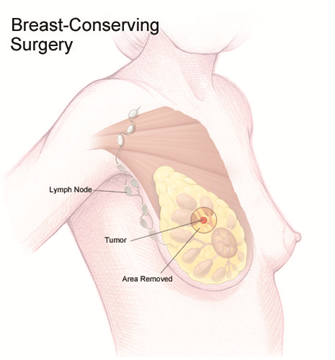
Breast-conserving surgery (BCS) may be used as part of a treatment plan for breast cancer. It is sometimes called a lumpectomy or a partial mastectomy depending on how much tissue is removed.

During BCS, only the part of the breast that has cancer is removed. The remainder of the breast is left intact. The cancer lump or abnormal tissue and some normal breast tissue around the lump (margin) are removed. How much of the breast is removed will depend on the lump’s size and its location.
The surgeon may also remove some of the lymph nodes under your arm to find out if the cancer has spread there. Breast cancer often spreads to these lymph nodes. It can then spread to other parts of the body (metastasize).
Radiation therapy is often given after BCS. This decreases the risk of the cancer returning. It destroys cancer cells that may not have been removed during surgery. In some cases, chemotherapy and radiation are both given after BCS.
BCS may be done as part of treatment for breast cancer. Deciding if you are a candidate for BCS depends on your type and stage of breast cancer and other factors. Your surgeon will discuss these with you during your consultation.
Studies show that women who have BCS for breast cancer followed by radiation therapy have similar long-term survival rates as women who have a mastectomy, which is when the entire breast is removed. There may be other reasons for your surgeon to advise BCS. But not all women can have BCS. Your surgeon will discuss these issues with you in detail, including all the choices for surgical treatment.
All surgeries have some risk. Some possible complications of BCS include:
A clear fluid (seroma) is often present in the wound after BCS. This can be drained in the surgeon’s office and treated with compression if needed.
There may be other risks depending on your specific health condition. Be sure to discuss any concerns with your healthcare team before the surgery.
Talk with your healthcare provider about how your breast may look after your surgery. Depending on how much of the breast is removed, it may look different afterward. Some type of reconstructive surgery may be a choice. Reconstruction can be done immediately after surgery or at a later time.
Talk with your healthcare team before surgery to know what to expect and what your choices are.
Your healthcare provider may have other instructions for you based on your health condition.
BCS may be done on an outpatient basis. This means you go home the same day. Or it may be done as part of a hospital stay. Procedures may vary depending on your condition and your healthcare provider's practices.
Generally, BCS follows this process:
After the procedure, you will be taken to the recovery room and watched closely. Your recovery process will vary depending on the type of procedure done and the anesthesia you are given. Once your blood pressure, pulse, and breathing are stable and you are alert, you may be taken to your hospital room.
In most cases, you will go home from the recovery room the same day as your surgery. You will receive instructions how to care for yourself at home and instructions when to call your healthcare provider.
Once you are home, keep the surgical area clean and dry. Your healthcare team will give you specific bathing instructions. If adhesive strips were used, they should be kept dry. They often fall off in a few days.
The amount of pain you have will vary. It depends on the amount and location of tissue removed during surgery. Soreness should decrease over time. Take a pain reliever as advised by your healthcare team. Aspirin and some other pain medicines may increase your chance of bleeding. Be sure to take only medicines advised by your provider.
Your provider may instruct you to keep wearing a bra for support, for a period of time.
You will likely go back to your normal activities in 2 weeks. In the meantime, don't do anything strenuous. Follow any restrictions from your healthcare provider. Don’t do things that need using your arm too much. This includes lifting heavy objects, cleaning windows, or vacuuming for a long time. Your provider will tell you when you can start driving again and when you can go back to work.
BCS may be followed by radiation therapy. Your healthcare team will advise you about this, depending on your situation.
Know the number to call your healthcare provider, including after office hours, on weekend, and holidays. Tell your provider if you have any of the following:
Your healthcare provider may give you other instructions, depending on your situation.
Removing lymph nodes during BCS may affect how lymphatic fluid drains from your arm. Problems with lymphatic drainage can cause swelling in your arm. You may also be at greater risk for infection from injury to your arm. And there is a higher risk for blood clots in your armpit veins after surgery to the area.
You will have to follow certain safety steps for the rest of your life after lymph node removal. This will help prevent problems in the affected arm. These safety steps include:
Your doctor may give you other instructions, depending on your situation.